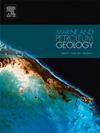Brine-saturated kaolinite mudrocks preserve capillary sealing to CO2 at high pressure and temperature
IF 3.7
2区 地球科学
Q1 GEOSCIENCES, MULTIDISCIPLINARY
引用次数: 0
Abstract
Caprock sealing capacity is essential for carbon geological storage in saline aquifers and depleted oil and gas formations. Clay-rich caprocks and fault gouge are expected to hold buoyant CO2 in the storage formation by capillary forces. However, all direct capillary sealing capacity measurements of clay-rich rocks to CO2 were so far limited to pressures below ∼20 MPa and/or temperatures below 50 °C, typically lower than target storage conditions. This paper presents new results of brine absolute permeability, capillary CO2 breakthrough pressure, and post-breakthrough CO2 permeability for resedimented kaolinite clay plugs at fluid pressures greater than 41 MPa, temperatures of 60 °C and 80 °C, and mean effective stress of ∼6.8 MPa. The results show that breakthrough pressure (PCO2 - Pw) is always positive and remains in the interval between ∼ 1.4 MPa and 2.8 MPa within the range of pressure and temperature explored. Moreover, average post-breakthrough CO2 relative permeability is ∼5 %. An additional test with a clay mixture representative of a shale from the North Sea, at similar pressure-temperature conditions held a differential pressure, i.e., no breakthrough, over three months with a maximum difference PCO2 - Pw = 5.71 MPa. Results and analysis support the water-wet properties of clays at high pressure and temperature and the resulting capillary sealing capacity to CO2. These results support expectations that clay-rich caprocks are satisfactory seals for holding buoyant CO2 via capillary forces. Results also suggest that if the sealing capacity is surpassed, clay-rich caprocks can limit advective flow because of their low CO2 relative permeability and potential for resealing through snap-off.
盐水饱和的高岭石泥岩在高压高温下保持对二氧化碳的毛细管密封性
在含盐含水层和枯竭油气层中进行碳地质封存时,毛岩的密封能力至关重要。富含粘土的毛岩和断层破碎带有望通过毛细力将浮力较大的二氧化碳封存在封存层中。然而,迄今为止,所有富粘土岩石对二氧化碳的直接毛细管封存能力测量都仅限于压力低于20兆帕(MPa)和/或温度低于50摄氏度(通常低于目标封存条件)的情况。本文介绍了在流体压力大于 41 兆帕、温度为 60 °C和 80 °C、平均有效应力为 6.8 兆帕的条件下,重结晶高岭石粘土塞的盐水绝对渗透率、毛细管二氧化碳突破压力和突破后二氧化碳渗透率的新结果。结果表明,在所探究的压力和温度范围内,突破压力(PCO2 - Pw)始终为正值,并保持在 1.4 兆帕至 2.8 兆帕之间。此外,突破后二氧化碳的平均相对渗透率为 5%。在类似的压力-温度条件下,用代表北海页岩的粘土混合物进行的另一项测试在三个月内保持了压差,即没有突破,最大差值为 PCO2 - Pw = 5.71 兆帕。结果和分析支持粘土在高压和高温下的水湿特性,以及由此产生的对二氧化碳的毛细管密封能力。这些结果支持了富含粘土的毛岩通过毛细力保持浮力二氧化碳的理想密封效果。结果还表明,如果超过了密封能力,富含粘土的毛岩可以限制平流,因为它们的二氧化碳相对渗透率较低,并有可能通过扣压重新密封。
本文章由计算机程序翻译,如有差异,请以英文原文为准。
求助全文
约1分钟内获得全文
求助全文
来源期刊

Marine and Petroleum Geology
地学-地球科学综合
CiteScore
8.80
自引率
14.30%
发文量
475
审稿时长
63 days
期刊介绍:
Marine and Petroleum Geology is the pre-eminent international forum for the exchange of multidisciplinary concepts, interpretations and techniques for all concerned with marine and petroleum geology in industry, government and academia. Rapid bimonthly publication allows early communications of papers or short communications to the geoscience community.
Marine and Petroleum Geology is essential reading for geologists, geophysicists and explorationists in industry, government and academia working in the following areas: marine geology; basin analysis and evaluation; organic geochemistry; reserve/resource estimation; seismic stratigraphy; thermal models of basic evolution; sedimentary geology; continental margins; geophysical interpretation; structural geology/tectonics; formation evaluation techniques; well logging.
 求助内容:
求助内容: 应助结果提醒方式:
应助结果提醒方式:


